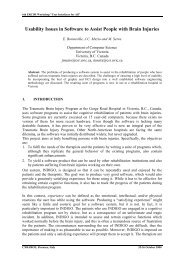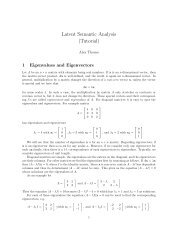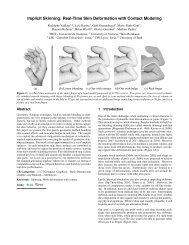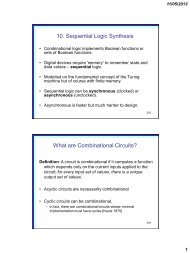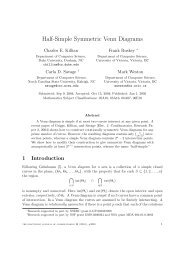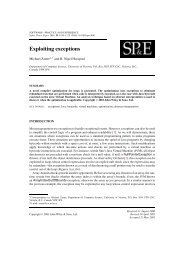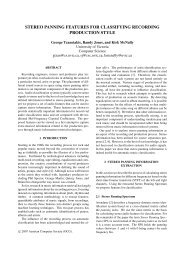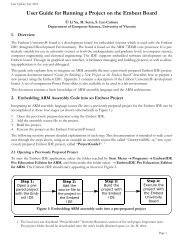The Search for Simple Symmetric Venn Diagrams - CiteSeerX
The Search for Simple Symmetric Venn Diagrams - CiteSeerX
The Search for Simple Symmetric Venn Diagrams - CiteSeerX
You also want an ePaper? Increase the reach of your titles
YUMPU automatically turns print PDFs into web optimized ePapers that Google loves.
<strong>The</strong> <strong>Search</strong> <strong>for</strong> <strong>Simple</strong><br />
<strong>Symmetric</strong> <strong>Venn</strong> <strong>Diagrams</strong><br />
Frank Ruskey, Carla D. Savage, and Stan Wagon<br />
Many people are surprised to learn<br />
that <strong>Venn</strong> diagrams can be drawn to<br />
represent all of the intersections of<br />
more than three sets. This surprise is<br />
perfectly understandable since small<br />
<strong>Venn</strong> diagrams are often drawn with circles, and it<br />
is impossible to draw a <strong>Venn</strong> diagram with circles<br />
that will represent all the possible intersections of<br />
four (or more) sets. This is a simple consequence of<br />
the fact that circles can finitely intersect in at most<br />
two points and Euler’s relationF−E+V = 2 <strong>for</strong><br />
the number of faces, edges, and vertices in a plane<br />
graph. However, there is no reason to restrict the<br />
curves of a <strong>Venn</strong> diagram to be circles; in modern<br />
definitions a <strong>Venn</strong> diagram is a collection of simple<br />
closed Jordan curves.This collection must have the<br />
property that the curves intersect in only finitely<br />
many points and the property that the intersection<br />
of the interiors of any of the 2n subcollections of<br />
the curves is a nonempty connected region.<br />
If a <strong>Venn</strong> diagram consists ofncurves then we<br />
call it ann<strong>Venn</strong> diagram. <strong>The</strong> rank of a region is<br />
the number of curves that contain it. In anyn<strong>Venn</strong><br />
n<br />
diagram there are exactly regions of rank r. r<br />
Figure 1 shows a 2<strong>Venn</strong> and two distinct 3<strong>Venn</strong><br />
diagrams. Note that the diagram in Figure 1(c) has<br />
three points where all three curves intersect. <strong>The</strong><br />
regions in the diagrams of Figure 2 are colored<br />
according to rank.<br />
<strong>The</strong> traditional threecircle <strong>Venn</strong> diagramhas an<br />
appealing 3fold rotational symmetry, and it is natural<br />
to ask whether there aren<strong>Venn</strong> diagramswith<br />
annfoldrotationalsymmetry<strong>for</strong>n>3.Grünbaum<br />
[6] found a symmetric 5<strong>Venn</strong> diagram made from<br />
ellipses. Henderson [10] noted the following necessary<br />
condition: if ann<strong>Venn</strong> diagram has annfold<br />
Frank Ruskey is professor of computer science at the University<br />
of Victoria, Canada. His research is supported in<br />
part by NSERC. Carla D. Savage is professor of computer<br />
science at North Carolina State University. Her email address<br />
is savage@ncsu.edu. Her research is supported in<br />
part by NSF grant DMS0300034. Stan Wagon is professor<br />
of mathematics at Macalester College. His email<br />
address is wagon@macalester.edu.<br />
rotational symmetry, thennis prime. <strong>The</strong> reason is<br />
as follows:<br />
Inanysymmetricn<strong>Venn</strong>diagramthefixedpoint<br />
of the rotations, the center of the diagram, must<br />
lie in the unique region of rankn. <strong>The</strong> unbounded<br />
outer region has rank 0. Regions of rank 0
(a) (b) (c)<br />
Figure 1: <strong>Symmetric</strong>n<strong>Venn</strong> diagrams <strong>for</strong>n=2, 3: (a)n=2, (b)n=3 simple, (c)n=3 nonsimple.<br />
Figure 2: <strong>Symmetric</strong> <strong>Venn</strong> diagrams: (a)n=5, (b)n=7, (c)n=11.<br />
can ask: Which <strong>Venn</strong> diagrams can be drawn with<br />
all curves convex? For more than four sets, the<br />
practical usefulness of <strong>Venn</strong> diagrams diminishes<br />
but interesting mathematical questions arise. See<br />
[14] <strong>for</strong> a list of open problems related to <strong>Venn</strong><br />
diagrams.<br />
In this article we outline the technique of Griggs,<br />
Killian, and Savage [5] <strong>for</strong> producing symmetric<br />
<strong>Venn</strong> diagrams on a prime number of curves and<br />
the more recent ef<strong>for</strong>ts of Killian, Ruskey, Savage,<br />
and Weston [13] to create simple symmetric<br />
<strong>Venn</strong> diagrams. One of the diagrams from [13]<br />
was selected by Stan Wagon as the basis <strong>for</strong> the<br />
illustration shown on the cover; the method used<br />
to produce the image is described in the “About the<br />
Cover” description on page 1312.<br />
Graph <strong>The</strong>oretic Model<br />
We first appealto graph theory to get a “combinatorial”<br />
condition <strong>for</strong> <strong>Venn</strong> diagrams.<br />
A <strong>Venn</strong> diagramD can be viewed as a (multi)graphV<br />
embedded in the plane: the vertices ofV<br />
are the points where curves ofDintersect and the<br />
edges ofV are the sections of the curves connecting<br />
the vertices. We can take the (geometric) dual of an<br />
embedding of a planar graphV by placing a vertex<br />
vr in every regionr ofV. If edgee separatesregions<br />
r ands inV, then joinvr andvs by an edge in the<br />
dual. <strong>The</strong> dualV ∗ of a <strong>Venn</strong> diagram is a planar embedding<br />
of a graph whose vertices are the subsets<br />
of[n]={1, 2,...,n}.<br />
To construct a <strong>Venn</strong> diagram, then, one could<br />
start with a graph whose vertices are the subsets<br />
of[n]. <strong>The</strong>ncubeQn is the graph whose vertices<br />
are thenbit strings with edges joining strings that<br />
differ only in one bit. Since a subsetS ⊆[n] can be<br />
viewed as annbit string whoseith bit is ‘1’ if and<br />
only ifi ∈ S, the vertices ofQn are in onetoone<br />
correspondence with the regions in a <strong>Venn</strong> diagram.<br />
ButQn is not planar <strong>for</strong>n≥4, so we cannot<br />
produce a <strong>Venn</strong> diagram simply by taking the dual<br />
ofQn.<br />
<strong>The</strong>re is a theorem in graph theory that says: In<br />
a planar graphG, ifS is a bond, that is, a minimal<br />
set of edges whose removal disconnectsG, then the<br />
edges in the dualG ∗ , corresponding to those inS,<br />
<strong>for</strong>m a cycle inG ∗ . For a proof, see West [16, <strong>The</strong>orem<br />
6.1.14]. This is exactly what is needed. IfG ∗<br />
is to be a <strong>Venn</strong> diagram, then <strong>for</strong> each 1 ≤ i ≤ n,<br />
the graphG ∗ must have a corresponding cycleCi<br />
December 2006 Notices of the AMS 1305
1111<br />
1110<br />
1100<br />
1000<br />
0000<br />
0111<br />
0110<br />
0100<br />
0101<br />
(a)<br />
1011<br />
1010 0011<br />
0010<br />
1101<br />
1001<br />
0001<br />
1111<br />
1110<br />
1100<br />
1000<br />
0000<br />
4<br />
3<br />
2<br />
1<br />
1<br />
2<br />
4<br />
3<br />
0111<br />
3<br />
0110<br />
4<br />
0100<br />
0101<br />
4<br />
1<br />
1011<br />
1<br />
1010 0011<br />
4<br />
0010<br />
3 4<br />
Figure 3: (a) A symmetric chain decomposition inB4; (b) embedding with cover edges, with each<br />
edge colored by its type.<br />
(a)<br />
1110<br />
1100<br />
1000<br />
0110<br />
0111<br />
0101<br />
1111<br />
0000<br />
2<br />
(b)<br />
3<br />
1101<br />
1010 0011 1001<br />
Figure 4: (a) An overlay with the dual of the graph in Figure 3(b); (b) the resulting <strong>Venn</strong> diagram<br />
<strong>for</strong> 4 sets (the two vertices with arrows are identified).<br />
to separate the sets containingi from those that do<br />
not. <strong>The</strong> dual ofCi back inG will be the set of edges<br />
joining vertices representing sets that do containi<br />
to those that do not, and this must be a bond ofG.<br />
A spanning subgraph ofQn is called monotoneif<br />
everynbit string withkones is adjacent to a string<br />
withk−1ones (ifk>0) and to a string withk+1<br />
ones (ifk
<strong>The</strong> chain starting atxcan be covered by the chain<br />
starting aty wherey is obtained fromxby changing<br />
the last ‘1’ inxto ‘0’. Not only doxandy differ in<br />
one bit, but so do the last elements of these chains.<br />
Viewingy’schainasthe parentofx’schain,itcanbe<br />
shown that a preorder layout of the tree of chains<br />
gives a planar embedding of the chains together<br />
with their cover edges. A planar embedding of the<br />
subgraph ofQ4 consisting of the chains and the<br />
cover edges is shown in Figure 3(b).<br />
<strong>The</strong> dual graph is shown in Figure 4(a). Say that<br />
an edge in the graph of Figure 3(b) has type i if<br />
it joins vertices that differ in positioni. In Figure<br />
4(a), a dual edge is colored according to the type of<br />
the edge it crosses. Figure 4(b) shows the resulting<br />
<strong>Venn</strong> diagram.<br />
This method gives yet another constructive<br />
proof that <strong>for</strong> everyn ≥ 0, <strong>Venn</strong> diagrams exist<br />
<strong>for</strong> n sets. (A similar construction is implicit in<br />
[2], although they make no mention of symmetric<br />
chains.) So what about rotational symmetry? As described<br />
earlier, this is not possible ifnis composite.<br />
But whennis prime, we can extract ideas from the<br />
construction described here to achieve symmetry,<br />
as shown in the next section.<br />
Rotational Symmetry Whennis Prime<br />
Whennis prime, the idea <strong>for</strong> constructing a rotationally<br />
symmetric <strong>Venn</strong> diagram is to somehow<br />
work within “1/nth” ofBn (orQn) to get “1/nth” of<br />
the <strong>Venn</strong> diagram embedded in a “1/nth” pieslice<br />
of the plane and then rotate the result by 2πi/n <strong>for</strong><br />
1 ≤ i < n to complete the diagram. Fortunately,<br />
whennis prime,Bn comes with a natural partition<br />
into symmetric classes.<br />
Forx=x1x2···xn, letσ denote the left rotation<br />
ofxdefined byσ(x) = x2x3···xnx1. Letσ 1 = σ,<br />
andσ i (x) = σ(σ i−1 (x)), wherei > 1. Define the<br />
relation△on the elements ofBn byx△y if and only<br />
ify = σ i (x) <strong>for</strong> somei ≥ 0. <strong>The</strong>n△is an equivalence<br />
relation that partitions the elements ofBn<br />
into equivalence classescalled necklaces. Whennis<br />
prime, everynbit string, other than 0 n and 1 n , has<br />
n distinct rotations, so its necklace has exactlyn<br />
elements.<br />
In the hope of adapting the method of the previous<br />
section, we ask: When n is prime, is there a<br />
way to choose a setRn of necklace representatives,<br />
one from each necklace, so that the subposet of<br />
Bn induced byRn,Bn[Rn] has a symmetric chain<br />
decomposition? Fortunately, the answer is yes (see<br />
next section), so construction of a rotationally symmetric<br />
<strong>Venn</strong> diagram can proceed as follows.<br />
Startwiththe strategicallychosensetRn ofnecklace<br />
representatives. LetQn[Rn] be the subgraph<br />
of Qn induced by Rn. <strong>The</strong> symmetric chain decomposition<br />
inBn[Rn], together with appropriate<br />
cover edges, gives a planar, spanning, monotone<br />
subgraph P of Qn[Rn]. Embed P in a 1/nth pie<br />
slice of the plane with 1 n at the center and 0 n at the<br />
point at infinity. Note that, as graphs,Qn[Rn] and<br />
Qn[σ i (Rn)] are isomorphic <strong>for</strong> any bitwise rotation<br />
σ i of the vertices. SoQn[σ i (Rn)] has a subgraph<br />
Pi isomorphic toP. <strong>The</strong>n rotating the embedding<br />
ofP by 2πi/n about the origin gives a planar embedding<br />
ofPi. Taken together, the embeddings of<br />
the Pi give a rotationally symmetric planar embedding<br />
of a spanning monotone subgraph ofQn<br />
and there<strong>for</strong>e the dual is a <strong>Venn</strong> diagram. Finally,<br />
the dual is drawn in a symmetric way. <strong>The</strong> entire<br />
process is illustrated <strong>for</strong>n = 5 in the sequence of<br />
Figures 5(a), (b), (c), (d). <strong>The</strong> chains inQ5[R5] are<br />
10000110001110011110 and 1010010110 (see<br />
the lowest “hexagon” in Fig. 5(a)).<br />
Choosing Necklace Representatives<br />
Here is a way to choose a setRn of necklace representatives,<br />
one from each necklace, so that the subposet<br />
ofBn induced byRn has a symmetric chain<br />
decomposition.<br />
Define the block codeβ(x) of a binary stringx<br />
as follows. Ifxstarts with ‘0’ or ends with ‘1’, then<br />
β(x)=(∞).Otherwise,xcanbe writteninthe <strong>for</strong>m:<br />
x=1 a1 0 b1 1 a2 0 b2 ···1 at 0 bt<br />
<strong>for</strong> somet > 0, whereai > 0,bi > 0, 1≤i ≤t, in<br />
which case,<br />
β(x)=(a1+b1,a2+b2,...,at+bt).<br />
As an example, the block codes of the string<br />
1110101100010 and all of its rotations are shown<br />
below.<br />
bit string block code bit string block code<br />
1110101100010 (4, 2, 5, 2) 1100010111010 (5, 2, 4, 2)<br />
0111010110001 (∞) 0110001011101 (∞)<br />
1011101011000 (2, 4, 2, 5) 1011000101110 (2, 5, 2, 4)<br />
0101110101100 (∞) 0101100010111 (∞)<br />
0010111010110 (∞) 1010110001011 (∞)<br />
0001011101011 (∞) 1101011000101 (∞)<br />
1000101110101 (∞)<br />
Whennis prime, no two different rotations of an<br />
nbit string can have the same finite block code. Assuming<br />
that block codes are ordered lexicographically,<br />
in each necklace ofnbit strings (except 0 n ,<br />
1 n ) the unique string with minimum block code can<br />
be chosen as the representative.<br />
For n prime, let Rn be the set of nbit strings<br />
that are the minimumblockcode representatives<br />
of their necklaces. Build chains using the Greene–<br />
Kleitman rule, except chains start with a string with<br />
exactly one unmatched ‘1’ and end at a string with<br />
exactly one unmatched ‘0’. Note that a nodexand<br />
its successory have the same block code, so ifxhas<br />
the minimum block code among all of its rotations,<br />
then so doesy. Thus every element of x’s chain<br />
is the (minimumblockcode) representative of its<br />
necklace.<br />
December 2006 Notices of the AMS 1307
00001<br />
10001<br />
01001<br />
00010<br />
10010<br />
11010<br />
11001<br />
01101<br />
11101<br />
00011<br />
10011<br />
11011<br />
11100<br />
11000<br />
(a)<br />
(c)<br />
10111<br />
11111<br />
11110<br />
10000<br />
00101<br />
10101<br />
10110<br />
10100<br />
01011<br />
01111<br />
00111<br />
01110<br />
00100<br />
00110<br />
01100<br />
01010<br />
01000<br />
00001<br />
10001<br />
10001<br />
01001<br />
00010<br />
10010<br />
11010<br />
11001<br />
11001<br />
00001 01101<br />
01001<br />
01101<br />
11101<br />
11100<br />
11000<br />
00011<br />
10011<br />
11011<br />
(b)<br />
10111<br />
11111<br />
11110<br />
10000<br />
00101<br />
10101<br />
10110<br />
10100<br />
01011<br />
01111<br />
01110<br />
00111<br />
01110<br />
11010 11011 10111 00111<br />
11101<br />
11100<br />
11000<br />
11110<br />
10000<br />
10110<br />
10100<br />
01111<br />
00100<br />
00110<br />
01100<br />
01011 01010<br />
Figure 5: Constructing a symmetric 5<strong>Venn</strong> diagram: (a) dual with symmetric chains highlighted,<br />
(b) the curves corresponding to the first chain cover, (c) repeating in each sector,<br />
(d) the final <strong>Venn</strong> diagram.<br />
<strong>Simple</strong>r <strong>Venn</strong> <strong>Diagrams</strong> and Euler’s<br />
Formula<br />
Recall that a <strong>Venn</strong> diagram is simple if at most two<br />
curvesintersectatanygivenpoint.Thismeansthat,<br />
viewed as a graph, every vertex of a simple <strong>Venn</strong> diagramhasdegree<br />
4.<strong>The</strong> numberoffacesis2 n ,since<br />
every subset of[n] corresponds to a region, and<br />
the number of edges is half the sum of the vertex<br />
degrees, so byV−E+F= 2, a simple <strong>Venn</strong> diagram<br />
has 2 n − 2 vertices. In contrast, the number of vertices<br />
in the <strong>Venn</strong> diagrams we have constructed via<br />
symmetric chain decompositions is the number of<br />
00010<br />
10010<br />
00011<br />
10011<br />
11111<br />
(d)<br />
00101<br />
10101<br />
00100<br />
00110<br />
01100<br />
01010<br />
01000<br />
01000<br />
<br />
n<br />
elements in the middle levels ofBn: , which ⌊n/2⌋<br />
is roughly 2n / √ n. This means that the average<br />
number of curves intersecting at any given point<br />
is about c √ n <strong>for</strong> some constant c. But a hidden<br />
feature of the Greene–Kleitman symmetric chain<br />
decomposition will allow a dramatic improvement.<br />
Since the number of faces of a <strong>Venn</strong> diagram is<br />
fixed and sinceV −E+F = 2, onceE > V, more<br />
vertices in the diagram mean the average degree is<br />
smaller and thus, on average, fewer curves intersect<br />
at any point. If the <strong>Venn</strong> diagram is the dual<br />
of a planar spanning monotone subgraphG ofQn<br />
1308 Notices of the AMS Volume 53, Number 11
00001<br />
10001<br />
01001<br />
00010<br />
10010<br />
11010<br />
11001<br />
01101<br />
11101<br />
00011<br />
10011<br />
11011<br />
11100<br />
11000<br />
(a)<br />
10111<br />
11111<br />
11110<br />
10000<br />
00101<br />
10101<br />
10110<br />
10100<br />
01011<br />
01111<br />
00111<br />
01110<br />
00100<br />
00110<br />
01100<br />
01010<br />
01000<br />
00001 01101<br />
01110<br />
01011 01010<br />
Figure 6: (a) <strong>The</strong> dual with two simplifying edges added in pie slice. (b) <strong>The</strong> effect of the cyan<br />
simplifying edge (compare with Fig. 5 (d)) is to increase the number of vertices from 10 to 15.<br />
that has been embedded in the plane, we can increase<br />
the number of vertices of the <strong>Venn</strong> diagram<br />
by increasing the number of faces ofG. One way<br />
to do this is to add edges ofQn toG, without destroying<br />
the planarity ofG. <strong>The</strong> added edges join<br />
vertices which differ in one bit. For example, Figure<br />
6 shows the addition of ten simplifying edges to the<br />
5<strong>Venn</strong> dual of Figure 5 and the effect that adding<br />
the five cyan ones has on the resulting 5<strong>Venn</strong> diagram.<br />
Note that the number of vertices increases<br />
from 10 to 15.<br />
<strong>The</strong> Greene–Kleitman symmetric chain decomposition<br />
provides a systematic way to do this: Any<br />
face bounded by two chains and two (suitably chosen)<br />
cover edges can always be “quadrangulated”<br />
by edges joining vertices that differ in one bit. This<br />
is illustrated in Figures 7 and 8. Furthermore, it can<br />
be shown that asn→∞, the number of vertices in<br />
the resulting <strong>Venn</strong> diagram is at least(2 n − 2)/2,<br />
so the averagenumber of curves intersecting at any<br />
given point is at most 3. Since(2 n − 2)/2 is half the<br />
numberofverticesinasimple<strong>Venn</strong>diagram,thediagrams<br />
of [13] were dubbed “halfsimple”. (Experiments<br />
suggest that asn → ∞, the construction is<br />
doing better than 50%, perhaps closer to 60%.)<br />
<strong>The</strong> construction is certainly not optimal. Figure<br />
9 shows that further simplifying edges ofQn,<br />
beyond those specified by the construction, can be<br />
added. To date the simplest symmetric 11<strong>Venn</strong><br />
diagram is due to Hamburger, Petruska, and Sali<br />
[9]; their diagram has 1837 vertices and is about<br />
90% simple.<br />
Figure 9 was the starting point <strong>for</strong> the halfsimple<br />
<strong>Venn</strong> diagram shown on the cover. Figure<br />
10001<br />
00010<br />
10010<br />
11001<br />
01001<br />
11010<br />
11101<br />
00011<br />
11011<br />
10011<br />
11100<br />
11000<br />
11111<br />
10000<br />
(b)<br />
00101<br />
10101<br />
10111<br />
11110<br />
10110<br />
10100<br />
00111<br />
01111<br />
00100<br />
00110<br />
01100<br />
01000<br />
10(a) shows the result of embedding the graph of<br />
Figure 9 in a “1/11th” pie slice of the plane and<br />
then rotating it by 2πi/11 <strong>for</strong> 1 ≤ i < 11 to get a<br />
monotone, planar, symmetric, spanning subgraph<br />
of Q11. Its dual, drawn by Wagon’s Mathematica<br />
program and shown in Figure 10(b), is a halfsimple,<br />
symmetric 11<strong>Venn</strong> diagram. <strong>The</strong> program<br />
regards (a) as a planar map, so the regions have<br />
been 4colored to highlight this interpretation.<br />
Figure 11(a) shows one curve of the 11<strong>Venn</strong> diagram.<br />
Each of the 11 curves is a rotation of this one.<br />
Figure 11(b) shows the <strong>Venn</strong> diagram with regions<br />
colored by rank and with one curve highlighted.<br />
Acknowledgements: We are grateful to Mark<br />
Weston and Nikolay Dinev <strong>for</strong> helpful discussions<br />
and to Mark <strong>for</strong> creating Figure 2(c). Thanks also<br />
to the referees <strong>for</strong> helpful comments. Support<br />
from the National Sciences and Engineering Research<br />
Council of Canada and the National Science<br />
Foundation is acknowledged and appreciated.<br />
References<br />
[1] Barry Cipra, Peter Hamburger, and Edit Hepp,<br />
Aesthetic aspects of <strong>Venn</strong> diagrams, Proceedings of<br />
the 2005 Bridges Conference on Mathematical Connections<br />
in Art, Music and Science, July 31–August<br />
3, 2005, Banff, Canada, 339–42.<br />
[2] Bette Bultena and Frank Ruskey, <strong>Venn</strong> diagrams<br />
with few vertices, Electronic Journal of<br />
Combinatorics, 5, R44, (1998), 21 pages.<br />
[3] Anthony W. F. Edwards, Sevenset <strong>Venn</strong> diagrams<br />
with rotational and polar symmetry, Combinatorics,<br />
Probability, and Computing, 7 (1998), 149–52.<br />
December 2006 Notices of the AMS 1309
1111110<br />
1111100<br />
1111000<br />
1110000<br />
1100000<br />
1000000<br />
1101110<br />
1101100<br />
1101000<br />
1001000<br />
1001110<br />
1001100<br />
(a)<br />
1011110<br />
1011100<br />
1011000<br />
1010000<br />
1010110<br />
1010100<br />
1111110<br />
1111100<br />
1111000<br />
1110000<br />
1100000<br />
1000000<br />
1101110<br />
1101100<br />
1101000<br />
1001000<br />
1001110<br />
1001100<br />
(b)<br />
Figure 7: <strong>Symmetric</strong> chain decomposition (a), with cover edges (b), and quadrangulated faces (c),<br />
inQ7[R7].<br />
01<br />
01<br />
01<br />
01<br />
Figure 8: <strong>Symmetric</strong> chain decomposition with cover edges and quadrangulated faces inQ11[R11]<br />
from the construction of [13].<br />
01<br />
01<br />
01<br />
01<br />
Figure 9: After manually adding extra edges, including wrapping edges, to the graph of Figure 8.<br />
[4] Curtis Greene and Daniel J. Kleitman, Strong<br />
versions of Sperner’s theorem, Journal of Combinatorial<br />
<strong>The</strong>ory, Series A, 20 (1976) 80–8.<br />
[5] Jerrold Griggs, Charles E. Killian, and Carla<br />
D. Savage, <strong>Venn</strong> diagrams and symmetric chain<br />
decompositions in the Boolean lattice, Electronic<br />
Journal of Combinatorics, 11 (1), R2, (2004), 30<br />
pages.<br />
[6] Branko Grünbaum, <strong>Venn</strong> diagrams and independent<br />
families of sets, Mathematics Magazine, 48<br />
(JanFeb 1975) 12–23.<br />
[7] , <strong>Venn</strong> diagrams II, Geombinatorics, 2 (1992),<br />
25–32.<br />
[8] Peter Hamburger, Doodles and doilies, nonsimple<br />
symmetric <strong>Venn</strong> diagrams, Discrete Mathematics,<br />
257 (2002), 423–39<br />
1011110<br />
1011100<br />
1011000<br />
1010000<br />
1010110<br />
1010100<br />
1111110<br />
1111100<br />
1111000<br />
1110000<br />
1100000<br />
1000000<br />
1101110<br />
1101100<br />
1101000<br />
1001000<br />
1001110<br />
1001100<br />
(c)<br />
1011110<br />
1011100<br />
1011000<br />
1010000<br />
1010110<br />
1010100<br />
[9] P. Hamburger, Gy. Petruska, and A. Sali,<br />
Saturated chain partitions in ranked partially ordered<br />
sets, and nonmonotone symmetric 11<strong>Venn</strong><br />
diagrams, Studia Scientiarum Mathematicarum<br />
Hungarica, 41 (2004), 147–91.<br />
[10] D. W. Henderson, <strong>Venn</strong> diagrams <strong>for</strong> more than<br />
four classes, American Mathematical Monthly, 70<br />
(1963), 42426.<br />
[11] Joan P. Hutchinson, Three coloring Siamese trees,<br />
Personal communication, 2006.<br />
[12] Joan P. Hutchinson and Stan Wagon, Kempe<br />
revisited, American Mathematical Monthly, 105<br />
(1998), 170–74.<br />
1310 Notices of the AMS Volume 53, Number 11
(a) (b)<br />
Figure 10: (a) <strong>The</strong> plane graph, derived from Figure 9, whose dual is a halfsimple 11<strong>Venn</strong><br />
diagram (with regions 4colored). (b) All 11 curves of the halfsimple 11<strong>Venn</strong> diagram created by<br />
taking the dual of the graph in (a).<br />
(a) (b)<br />
Figure 11: (a) One curve of the halfsimple 11<strong>Venn</strong> diagram. (b) <strong>The</strong> halfsimple 11<strong>Venn</strong><br />
diagram, with regions colored according to rank, and one curve highlighted.<br />
[13] Charles E. Killian, Frank Ruskey, Carla D.<br />
Savage, and Mark Weston, Halfsimple symmetric<br />
<strong>Venn</strong> diagrams, Electronic Journal of<br />
Combinatorics, 11 (1), R86, (2004), 22 pages.<br />
[14] Frank Ruskey and Mark Weston, A survey<br />
of <strong>Venn</strong> diagrams, Electronic Journal of<br />
Combinatorics, 4 DS5, (1997), (updated 2001,<br />
2005).<br />
[15] John <strong>Venn</strong>, On the diagrammatic and mechanical<br />
representation of propositions and reasonings,<br />
<strong>The</strong> London, Edinburgh, and Dublin Philosophical<br />
Magazine and Journal of Science, 9 (1880), 1–18.<br />
[16] Douglas B. West, Introduction to Graph <strong>The</strong>ory,<br />
Second edition, 2001.<br />
December 2006 Notices of the AMS 1311



